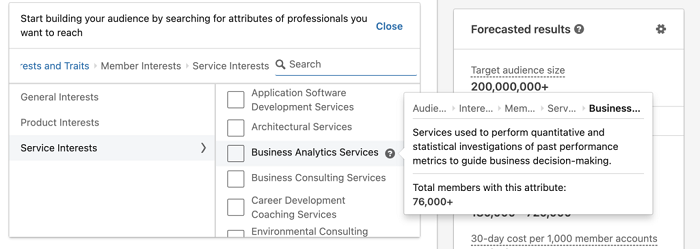You now have more ways to target your ads on LinkedIn, with the platform adding a range of new Service interest attributes, and over 120 new Product interest options, to help refine your audience targeting.
As per LinkedIn:
“With 90K+ Product Pages, 6.1MM Service Pages, and interactions on Linkedin Pages increasing 48% year over year, we know brands and members are turning to LinkedIn to showcase their products and services, igniting interest and engaging with buying committees.”
Based on this – and that massive growth in Page interactions, LinkedIn has built in a new set of qualifiers for your audience targeting, which will provide more ways to drill-down to specific audiences in the app.

LinkedIn says that there are now over 400+ professional interest categories, across business technology, financial management services, cybersecurity software, and more, which you can use to hone in on your specific target audience, and maximize results from your LinkedIn ad spend.
Specifically, LinkedIn has added new product categories, with a focus on software.
“With subcategories that zero in on specifics like data visualization software, revenue management software, and sales analytics software.”
LinkedIn has also added a range of new Service interests:
“You can leverage these activities and the LinkedIn Economic Graph to create more tailored campaigns and reach members interested in the services you provide. Our initial set of ~20 categories includes services such as real estate, environmental consulting, and application software development.”

These advanced options will give you more ways to connect with just the right people in the app – and with more people turning to LinkedIn than ever, now could be a great time to try out its ad options, and see what results you get.
In addition to this, LinkedIn recently conducted a study, in partnership with Nielsen, in order to identify the top ad approaches for B2C brands.
The study, which looked at 144 campaigns, found that B2C campaigns on LinkedIn work best when they focus on Aspiration, innovation and Loyalty.
- Aspirational messaging is all about connecting your brand to desirability – for example, showing why driving your vehicle will bring a more adventurous lifestyle.
- Innovation-based messaging focuses on new ideas and unique products. Either the content itself is unique, or the experience of using the product/service feels unique to consumers.
- Loyalty-based messaging, meanwhile, contributes to mid-funnel Favorability. Does your brand reflect your audience’s values? Would consumers say that they love your brand?
LinkedIn says that focusing on these aspects will help drive better results, by better connecting with its audience and their desires.
In combination with these new audience targeting options, you could have a direct formula for constructing your LinkedIn campaigns.
You can read more about LinkedIn’s B2C ads study here.



